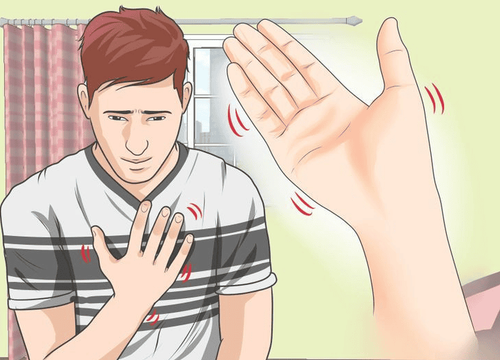This is an automatically translated article.
The article was professionally consulted by Specialist Doctor I Nguyen Thi My Linh - Neonatologist - Department of Pediatrics - Neonatology - Vinmec Danang International General Hospital.Stockholm syndrome refers to symptoms that can occur in a person who is in a hostage or prisoner situation. Often, these feelings can be described as sympathy for the captors or the development of a relationship with the captors. This reaction can also be recognized in people who have left religions, abusive relationships, or other traumatic situations.
Stockholm syndrome is not a recognized psychological diagnosis, but rather an attempt to explain the symptoms present in certain individuals in captivity. A person experiencing Stockholm syndrome develops an attachment to the captor and may experience feelings of love, empathy, or a desire to protect the captor.
A person who develops Stockholm syndrome often experiences symptoms of post-traumatic stress: nightmares, insomnia, flashbacks, tendency to startle easily, confusion, and difficulty trusting others.
In addition to cases, normal people can also develop Stockholm syndrome in response to different types of trauma. In this article, we'll take a closer look at exactly what Stockholm syndrome is, what it's called, the types of situations that can predispose someone to it, and what to do about it. definitive treatment of Stockholm syndrome.

1. What is Stockholm syndrome?
Stockholm syndrome is a psychological reaction that occurs when hostages or victims of a kidnapping are linked with their kidnappers or abuse or hold them. This psychological connection develops over the course of days, weeks, months, or even years of confinement or abuse.For Stockholm syndrome, hostages or abuse victims may have feelings of empathy for their captor. This is in stark contrast to the fear, horror or even contempt that many people often think of when it comes to the psychology of the victims of a kidnapping.
Over time, some victims develop positive feelings towards the very people who are capturing and holding them. They may even begin to feel empathy for these people and develop negative feelings towards the police, the government or even those trying to free them.
Sometimes people with Stockholm syndrome even resent anyone trying to get them out of a dangerous situation they are in. This paradox appears in only a few hostages and so far, psychologists have not been able to explain the cause of the victims' Stockholm syndrome.
Many psychologists and medical professionals see Stockholm syndrome as a coping mechanism or a way to help victims deal with trauma in dire circumstances.
2. History of Stockholm Syndrome
Cases of Stockholm syndrome have appeared many centuries ago. However, it was not until 1973 that this response to detention or abuse was given a name. It was in a case where two criminals held 4 people hostage for 6 days after a bank robbery in Stockholm, Sweden. After being rescued, the hostages refused to testify against their captors, even standing up to raise money to hire lawyers to defend the two robbers.Soon after, psychologists and mental health experts stepped in to find out the reason for this paradox. They have assigned the term "Stockholm syndrome" to describe the condition that occurs when hostages develop an emotional or psychological connection with their captors.
Although well known, however, Stockholm syndrome is not recognized by the new edition of the Diagnostic and Statistical Manual of Mental Disorders, a manual used by health professionals. mental health and other professionals to diagnose mental health disorders.

3. Symptoms of Stockholm syndrome
Stockholm syndrome can be identified through three distinct symptoms, including:Victims develop positive emotions towards those who are incarcerating or abusing them Victims develop negative emotions negative tendencies towards the police, authorities or authority figures or anyone trying to free them from their captors. They even refuse to cooperate against them. Victims begin to perceive their captors as they are and believe they have the same goals and views as they do. These feelings often occur when the victim feel scared. For example, people who are kidnapped or held hostage often feel threatened by their captor, but they also rely heavily on them to survive. If the kidnapper or abuser shows kindness to them, they may begin to feel positive towards their captor because of this “compassion”. Over time, that perception gradually reshapes their thinking and distorts their perception of their hostage or abuser.
An example of classic Stockholm syndrome is the case of Patty Hearst, the niece of businessman and newspaper publisher William Randolph Hearst who was kidnapped in 1974 by the Symbionese Liberation Army (SLA). ).
During her captivity, she abandoned her family, took a new name, and even joined the SLA to rob a bank. Then, Hearst was arrested and she used Stockholm syndrome as a defense in her trial. That defense was fruitless and she was sentenced to 35 years in prison.
Another recorded case of Stockholm syndrome is Natascha Kampusch. In 1998, 10-year-old Natascha was kidnapped and held underground in a dark, insulated room. Her captor, Wolfgang Přiklopil, imprisoned her for more than eight years.
During that time, although he showed many good signs towards the girl, he also beat and threatened to kill her. Natascha managed to escape, and Přiklopil committed suicide. Newspapers at the time carried out reports describing Natascha "crying for no reason." upon hearing that the kidnapper committed suicide.
Mary McElroy. In 1933, four men detained 25-year-old Mary, chained her to a wall in an abandoned farmhouse, and demanded money from her family to ransom Mary. When she was released, she even refused to testify the names of her captors in the ensuing trial. She also openly expressed sympathy for them.

4. Stockholm syndrome in today's society
Typically, Stockholm syndrome is associated with abductions, incarceration or abuse, but it can also be the result of other circumstances or relationships, including:Relationships Abuse: Studies have shown that people who are abused can develop an emotional attachment to their abuser. Sexual, physical and emotional abuse, as well as incest, can last for many years. Through this time, a person may develop positive feelings or sympathy for their abuser. Child Abuse: Abusers frequently threaten their victims with violence, which can even lead to their death. The victim may try to avoid infuriating the abuser by complying. The abuser may also display kindness that could be seen as sincere affection. This can confuse children and lead to them not understanding the negative nature of the relationship. Trafficking in women and children : Trafficked persons often rely on their abusers for basic needs, such as food and water. When abusers provide that, victims can begin to develop positive emotions and gradually come to believe the abusers. They may also resist cooperating with police out of fear of retaliation or thinking they must protect abusers to protect themselves. Sports Coaching: Participating in sports is a great way for people to build skills and relationships. Unfortunately, some relationships can end up being negative. Harsh training techniques can even become abusive. Athletes may tell themselves the coach's behavior is in their best interest and this, according to a 2018 study, could eventually turn into a form of Stockholm syndrome.
5. Treatment of Stockholm syndrome

Psychology Clinic - Vinmec International General Hospital officially came into operation in April 2019, has the function of examining, consulting and outpatient treatment of psychological problems and psychological health. With modern equipment, Vinmec Mental Health Clinic is currently cooperating with experienced professors and experts. Along with the combination of implementing psychological tests, specialized psychotherapy for diagnosis and treatment, in order to bring the best medical examination and treatment effect.
Psychologists and psychotherapists can teach you coping mechanisms and response tools to help you understand what happened, why it happened, and how you can get over it. through it. Reframing your positive emotions can help you understand that what happened was not your fault.
Stockholm syndrome can be thought of as the body's way of dealing with incarceration, abduction or abuse. Fear is the most common in this situation, but some individuals begin to develop positive feelings towards their captor or abuser. They may not cooperate with the police, and may even be hesitant to report the behavior of their kidnappers.
Stockholm syndrome is not a mental health diagnosis, rather it is seen as a coping mechanism of the body. Individuals who are abused, trafficked, or victims of incest or terrorism can also develop this syndrome.
Please dial HOTLINE for more information or register for an appointment HERE. Download MyVinmec app to make appointments faster and to manage your bookings easily.
Articles refer to sources: healthline.com, thehealthsite.com













